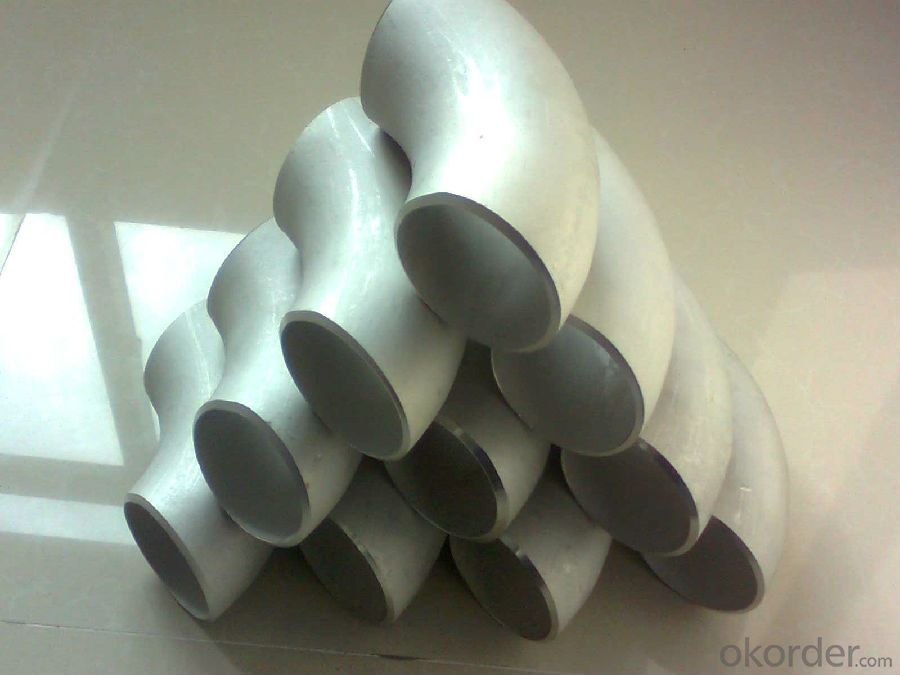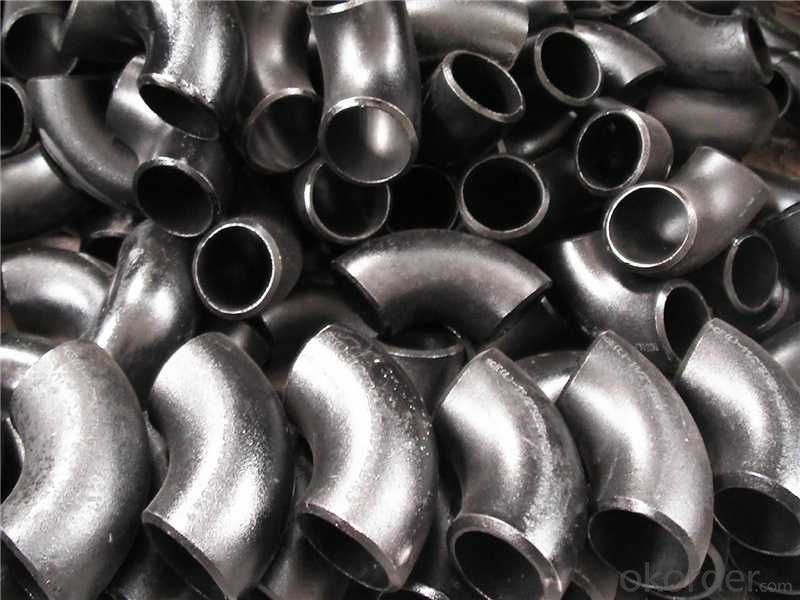Ansi ,Din,jis Stainless Steel Elbow from CNBM
- Loading Port:
- Tianjin
- Payment Terms:
- TT OR LC
- Min Order Qty:
- 100 m.t.
- Supply Capability:
- 3000 m.t./month
OKorder Service Pledge
OKorder Financial Service
You Might Also Like
Product Description:
1、 Structure of Ansi ,Din,jis Stainless Steel Elbow Description:
Stainless Steel Elbow is a kind of common pipe fitting used to switch the directions of pipelines in the pipe system. It can allow the pipeline to make a turn at an angle. The features of stainless steel can provide some benefits for the elbow. Because of the chromium content, the stainless steel elbow can be used for longer time. The stainless steel elbow can be widely used in various industries equipments.
2、Main Features of Ansi ,Din,jis Stainless Steel Elbow:
Relatively light weight
Optional torsional strength
Support high pressure
Resist corrosion
Reasonable price
3、 Ansi ,Din,jis Stainless Steel Elbow Images:



4、 Ansi ,Din,jis Stainless Steel Elbow Specification:
HOT SALE elbow
1 Radius:1D-3D
2 size: DN15~DN1800
3.Thickness : 2.8~60mm.
4.Certificate : ISO9001:2000 ,API.
FIRST :the information of our company
we specialize in this field for 14 years, Existing staff more than 300 people, fixed assets of 4 million dollars, current assets 8 million dollars, My company more than 90% for exports,.We have passed ISO9001:2000, API certifications.
SECOND :the standard of the products
Standard: | ANSI B16.9/16.28,ASME B36.10M-1996. |
JIS P2311 /2312/2313 SGP | |
DIN 2605 / 2615/2616/2617 | |
GOST 17379-2001 /17375-2001 /30753-2001/17378-2001 | |
API | |
BS | |
EN | |
GB |
Elbow | DN15~DN1800 |
Flange | DN~DN4000 |
Tee | DN15~DN1800 |
Reducer | DN15~DN1800 |
Cap | DN15~DN1800 |
Seamless Steel pipe | DN15~DN600 |
ERW | DN15~DN1800 |
SSAW | DN200~DN3600 |
LSAW | DN300~DN1400 |
Wall thickness | SCH10-XXS |
THIRD :the information of the products
Stainless steel elbow | |
Other productions: | butt welded and seamless pipe fittings , such as tee, cross, cap, bend, 45D/90D/180D LR/SR elbow. |
Material: | Carbon steel (ASTM A234WPB, A234 WPC , A420 WPL6 ). St45.8 A105 A106 STPG42 |
Stainless steel (ASTM A403 WP304/WP304L/WP316/WP316L). | |
Alloy steel (ASTM A234 WP12/WP11/WP22/WP5/WP9/WP91). | |
Size: | Seamless elbow:1/2"~24" DN15~DN600 |
Welded Elbow: 1/2”~72" DN15~DN1800 | |
Thickness: | SCH10~SCH160,STD ,XS ,XXS sch5s, sch20s, sch40s, sch80s,SGP./ 2.8mm~60mm |
Surface treatment: | Transparent oil, rust-proof black oil hot galvanized |
Productivity: | 1000 T/month |
Min order: | 100pieces |
Delivery Term: | FOB(30deposite the balance before shipment) CIF or C&F(30% deposite , the balance aginst with the copy of B/L) |
Remark: | 1. Special design available according to requirement 2. All the production process are made under the ISO9001:2000 ,API,CCS |
5、FAQ of Ansi ,Din,jis Stainless Steel Elbow
①How to guarantee the quality of the products?
We have established the international advanced quality management system,every link from raw material to final product we have strict quality test;We resolutely put an end to unqualified products flowing into the market. At the same time, we will provide necessary follow-up service assurance.
②How long can we receive the product after purchase?
In the purchase of product within three working days, We will arrange the factory delivery as soon as possible. The pecific time of receiving is related to the state and position of customers.
③ How can we get more information?
You can contact us by Email or call us directly and we will do our best to give you valuable information as much as possible but this service is not available on weekends.
- Q:Are steel pipes suitable for use in sewage treatment plants?
- Yes, steel pipes are suitable for use in sewage treatment plants. Steel pipes are durable, corrosion-resistant, and can withstand high-pressure applications, making them an ideal choice for transporting and containing sewage in treatment plants. Additionally, steel pipes can be easily welded, allowing for seamless connections and minimizing the risk of leaks or contamination.
- Q:How are steel pipes used in the manufacturing of wastewater treatment systems?
- Steel pipes are commonly used in the manufacturing of wastewater treatment systems as they provide a durable and corrosion-resistant material for transporting and distributing water and chemicals within the system. They are used for various purposes such as conveying wastewater, carrying treated water to different stages of the treatment process, and transferring chemicals for disinfection or filtration. Additionally, steel pipes are often used for constructing the framework and support structures of wastewater treatment systems due to their strength and versatility.
- Q:What is the maximum length of a steel pipe?
- The maximum length of a steel pipe will vary depending on various factors such as manufacturing capabilities, transportation limitations, and practical considerations. However, in general, steel pipes can typically be manufactured and transported in lengths ranging from a few meters to several hundred meters.
- Q:Are steel pipes resistant to vibration?
- Yes, steel pipes are generally resistant to vibration due to their inherent strength and rigidity. However, the level of resistance can vary depending on factors such as pipe thickness, design, and installation. Additionally, the presence of external factors like fluid flow or mechanical forces can also affect the level of vibration resistance.
- Q:How are steel pipes used in the manufacturing industry?
- Steel pipes are used in the manufacturing industry for a wide range of applications, including the transportation of fluids and gases, structural support in buildings and infrastructure, and as a material for heat exchangers and boilers. They are also utilized in the production of various machinery and equipment, such as conveyors, cranes, and industrial piping systems. Overall, steel pipes play a crucial role in ensuring efficient and reliable operations across numerous manufacturing processes.
- Q:Can steel pipes withstand high temperatures?
- Yes, steel pipes can withstand high temperatures as they have a high melting point and excellent heat resistance properties, making them suitable for various industrial applications involving high temperature environments.
- Q:How are steel pipes used in the infrastructure development?
- Steel pipes are widely used in infrastructure development as they provide strength, durability, and versatility for various applications. They are commonly used in the construction of bridges, highways, and buildings as structural elements. Steel pipes are also used in water and sewage systems, as they have excellent corrosion resistance and can withstand high pressure. Additionally, steel pipes are used for transporting oil, gas, and other fluids, making them crucial for the energy industry. Overall, steel pipes play a vital role in the development and maintenance of infrastructure, ensuring its stability and functionality.
- Q:How are steel pipes measured and sized?
- Steel pipes are commonly measured and sized based on their outer diameter (OD) and wall thickness. The OD is measured using a caliper or tape measure, while the wall thickness can be determined by either a micrometer or ultrasonic thickness gauge. This information is crucial for classifying pipes into various standardized sizes, such as schedule or nominal pipe sizes, which are widely used in the industry.
- Q:How do you calculate the maximum allowable deflection for steel pipes?
- When calculating the maximum allowable deflection for steel pipes, various factors must be taken into account. These factors include the pipe diameter, material properties, support conditions, and desired level of deflection. The maximum allowable deflection is typically determined according to industry standards and codes. One popular method for calculating the maximum allowable deflection is based on the pipe's span-to-diameter ratio, also known as the L/D ratio. The L/D ratio is calculated by dividing the pipe's span (the distance between supports) by its diameter. Numerous industry codes provide guidelines for the maximum allowable deflection based on the L/D ratio. For instance, the American Society of Mechanical Engineers (ASME) B31.1 Power Piping Code suggests that for carbon steel pipes, the maximum allowable deflection should not exceed 3% of the pipe's span when the L/D ratio is 100 or less. However, as the L/D ratio increases, the deflection limit decreases to ensure the pipe's stability and structural integrity. To calculate the maximum allowable deflection using the L/D ratio method, you first need to determine the L/D ratio based on the pipe's span and diameter. Then, you can refer to the applicable code or standard to find the corresponding maximum allowable deflection limit. It's important to note that other factors, such as the pipe material's yield strength, wall thickness, and the type of loading (e.g., dead load, live load), also influence the maximum allowable deflection. Therefore, it is crucial to consult the relevant industry standards, codes, and engineering principles to accurately calculate the maximum allowable deflection for steel pipes.
- Q:How are steel pipes used in oil and gas industry?
- Steel pipes are extensively used in the oil and gas industry for various purposes such as drilling, transporting, and processing oil and gas. They are primarily used as casing pipes, which provide structural support and prevent the collapse of boreholes during drilling operations. Steel pipes are also used for transporting crude oil and natural gas from the wellhead to processing facilities or distribution points. Furthermore, they play a crucial role in the construction of pipelines for long-distance transportation of oil and gas, ensuring efficient and reliable delivery. Additionally, steel pipes are utilized in the construction of oil and gas refineries and petrochemical plants for various processes, including fluid transportation, heat exchange, and storage.
1. Manufacturer Overview |
|
|---|---|
| Location | |
| Year Established | |
| Annual Output Value | |
| Main Markets | |
| Company Certifications | |
2. Manufacturer Certificates |
|
|---|---|
| a) Certification Name | |
| Range | |
| Reference | |
| Validity Period | |
3. Manufacturer Capability |
|
|---|---|
| a)Trade Capacity | |
| Nearest Port | |
| Export Percentage | |
| No.of Employees in Trade Department | |
| Language Spoken: | |
| b)Factory Information | |
| Factory Size: | |
| No. of Production Lines | |
| Contract Manufacturing | |
| Product Price Range | |
Send your message to us
Ansi ,Din,jis Stainless Steel Elbow from CNBM
- Loading Port:
- Tianjin
- Payment Terms:
- TT OR LC
- Min Order Qty:
- 100 m.t.
- Supply Capability:
- 3000 m.t./month
OKorder Service Pledge
OKorder Financial Service
Similar products
New products
Hot products
Related keywords






























